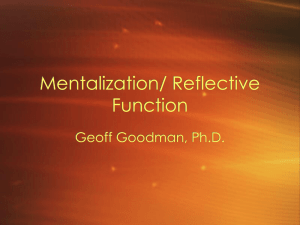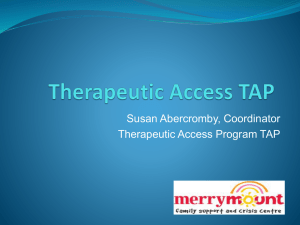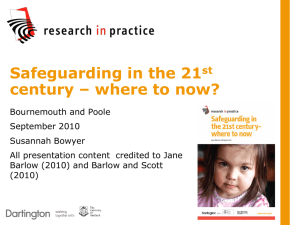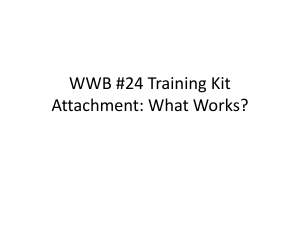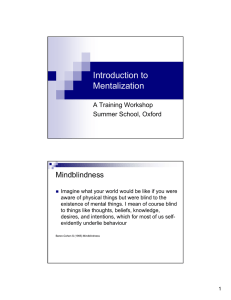FEAR and ATTACHMENT
advertisement
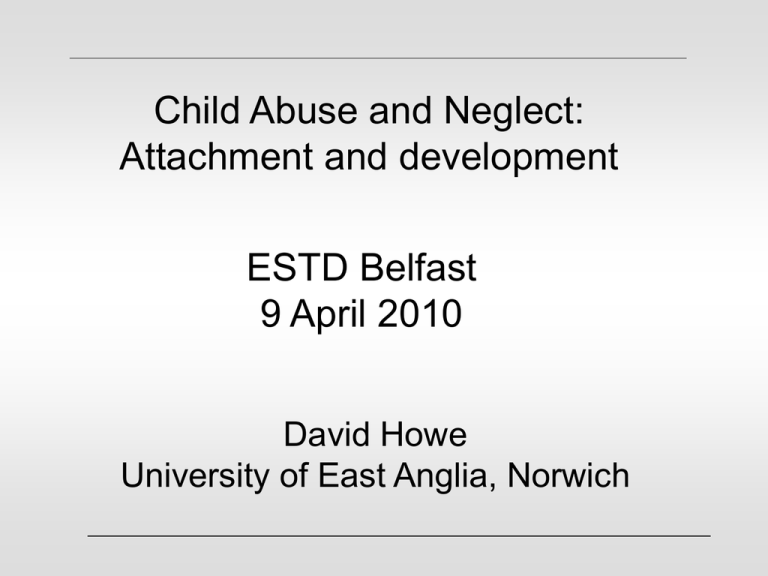
Child Abuse and Neglect: Attachment and development ESTD Belfast 9 April 2010 David Howe University of East Anglia, Norwich John Bowlby 1907 - 1990 Behavioural systems • Attachment system attachment • Exploratory/ prosocial system • Caregiving system behaviour exploratory behaviour caregiving behaviour SURVIVAL Attachment system REGULATION physiological, emotional, cognitive Intersubjectivity cortex limbic system brain stem cerebellum Bruce Perry: The ChildTrauma Academy, 5161 San Felipe, Suite 320 Houston, Texas 77056 (also see B. Perry 2008, The Boy Who Was Raised as a Dog Basic Books) Affect regulation How young minds form in the context of close relationships (Allan Schore) ATTACHMENT None of us in born with the capacity to regulate our own emotions. The caregiver- child regulatory system evolves where the infant’s signals of changes in state are understood and responded to by the caregiver, thereby becoming more regulated - co-regulation of affect. Peter Fonagy 2000 Sensitivity and mentalisation The parents’ capacity to observe the child’s mind seems to facilitate the child’s general understanding of minds, and hence his/her self-organisation through the medium of a secure attachment. Peter Fonagy Mentalisation: Peter Fonagy and Patrick Luyten 2009 The child has the opportunity to ‘find himself/herself in the other’ as someone with thoughts and feelings - with a mind. The child recognises themselves and others as intentional beings. Mentalisation is the imaginative mental activity that enables us to perceive and interpret human behaviour in terms of intentional mental states. Impairments in mentalisation play a role in a variety of psychopathologies of the self. Internal working model: cognition • self • others • relationship nb Kenneth Craik (1943) and J. Z. Young A Model for the Brain 1964. Patterns of attachment SECURE INSECURE organised INSECURE organised AVOIDANT AMBIVALENT INSECURE DISORGANISED Helpless/hostile caregiving The helpless stance involves failing to provide protection and regulation for the child Helpless states of mind - without strategies - a state in which the parent abdicates care and protection for the child, failing to terminate the child’s attachment system. Mentalisation goes ‘off-line’ Helpless/hostile caregiving Feelings of fear, helplessness and hostility which result in frightening/ frightened behaviour might be the result of parents being unable to control frightening memories or emotions associated with their own childhood loss/traumas. Helpless/hostile caregiving Helpless states of mind - infant’s pain and fear evokes carer’s own past unresolved losses and fears + helplessness to know how to find comfort and safety. Carers find it difficult to hear, respond to and help modulate fear and distress in their child. Carers therefore both evoke fear in their children AND fail to recognise it. Disorganised/disorientated attachments: infancy Disorganised attachments arise when the attached infant has been alarmed by the parent rather than the external situation. The parent is experienced as: Frightening physically alarming/hostile dangerous parental behaviour Frightened psychologically alarming parental behaviour/helpless Simultaneous activation of two incompatible behavioural responses: FEAR (avoidance) and ATTACHMENT (approach) fear without escape; fright without solution. E. Hesse and M. Main Abandonment Aloneness Rejection Danger Relational trauma Caregiving and disorganised attachments • Physical, emotional and/or sexual abuse, including rejection • Severe neglect and deprivation • Misuse/abuse of alcohol/drugs • Serious affective disorder eg depression • Unresolved losses/childhood traumas • Domestic violence • Multiple placements Disorganised attachments in young childhood ecological transactions mediators Adult psychopathology Maltreated Children Many abused and neglected children find mentalisation hard, particularly in interpersonal and intimate relationships because mentalising interactively is one of the most complex tasks. It is at these times that we are all vulnerable to hyperarousal and we need a buffer to protect us against overwhelming affect – it is mentalisation that acts as a cushion. Bateman and Fonagy 2004 Maltreated Children For maltreated children, hyperarousal throws mentalisation ‘off-line’ – the result is panic, impulsive behaviour, fight-flight response: makes children aggressive, impulsive, needy, frightened. Under extreme trauma, a freezedissociative response is more likely. Bateman and Fonagy 2004 For example, Borderline Personality Disorder: Fearful and preoccupied attachments, emotionally needy, feelings of being unloved and vulnerable, painful intolerance of aloneness, hypersensitivity to social environment, expectation of hostility from others, elevated rates of co-morbidity with dissociation, disturbed sense of identity, poor mentalization, poor self-regulation, poor sense of self agency. Relationship chaos. Strong links with emotional neglect and emotional maltreatment in early childhood – child’s internal experiences not adequately recognised, mirrored, enjoyed. Low arousal/stress threshold in the context of close relationships sees a switch from executive (mentalising) to automatic (flight or fight) responding. Therefore low threshold of attachment system activation + simultaneous switch to low mentalisation, both of which further intensify the relationship with the other. P. Fonagy and P. Luyten 2009: A developmental, mentalization-based approach…to BPD, Development and Psychopathology, 21, pp 1355-81 We hypothesize that that the failure to think and reflect about self, others and feelings might leave the individual with difficulties in decoupling their representations of another person’s experience from their own selfrepresentations (reflected in terms of brain structures subserving the processes of knowing self and others). P. Fonagy and P. Luyten 2009: A developmental, mentalization-based approach…to BPD, Development and Psychopathology, 21, pp 1355-81 When mentalization fails, any sense of loss, rejection, abandonment or disinterest in the context of a close relationship feels catastrophic. There is the constant danger of being overwhelmed by the other’s mental state. Psychic equivalence – subjective experience feels intensively real. Fight-flight responses. Emotional neglect + abuse/trauma: freeze, dissociative response (pretend mode losing connection with reality). Controlling Children Controlling strategies empower the child, allowing them to disown representations of the self as helpless, vulnerable and needing comfort - with this some degree of mental and behavioural coherence is achieved. However, when the child’s attachment system is strongly activated, this coherence is quickly destroyed: irrational, catastrophic, self-destructive ideation Under such stresses, the fragile unitary representation of the self as ‘controlling’ is underpinned by a disorganised, dissociated iwm of self. Controlling behaviours compulsive caregiving/parentification compulsive compliance compulsive self-reliance aggressive/punitive behaviours Bowlby (1980) proposed 2 major defensive strategies: defensive exclusion, and ‘segregation of principal systems.’ Both have the effect of shutting available, but potentially anxiety-provoking, information out of awareness. Segregated mental systems is the more severe defence – it occurs when 2 or more selves are segregated from each other – walled off - each having access to its own sectionalised memory store or internal working model = dissociative processes, including DID. The selves can alternate in consciousness, but generally only one is dominant at any one time. Liotti, G. (2004). Trauma, dissociation, and disorganized attachment: three strands of a single braid. Psychotherapy: theory, research, practice and training, 41: 472-86. helpless – hostile fearful – out-of-control unresolved caregiving Helpless victim frightened compliant sad Hostile persecutor controlling punitive aggressive self-reliant frightening bad/evil Protective controlling caregiving rescuer comforting disorganised/rage/out-of-control/dissociation Liotti also found that 62% of adults diagnosed with dissociative disorders had mothers who had lost a close relative within 2 years of their children’s birth. Similar risk also found if mother also suffered a traumatic experience within 2 years of child’s birth. Trauma and stress pile-up: Allen 2001 PAST TRAUMA: afraid and alone Sensitised nervous system CURRENT STRESS: reminders of trauma Unbearably painful emotional states RETREAT isolation dissociation depression SELF-DESTRUCTIVE ACTIONS substance abuse eating disorders self-harm suicidal ideation DESTRUCTIVE ACTS aggression violence rages Bruce Perry: The ChildTrauma Academy, 5161 San Felipe, Suite 320 Houston, Texas 77056 (also see B. Perry 2008, The Boy Who Was Raised as a Dog Basic Books) Bottom-up, inside to outside Respond to developmental age and not chronological age Relationships as the most powerful of therapeutic experiences behavioural and cognitive development social support and relationships peer relationships social cognition, understanding, empathy mentalisation, play, attunement, affect regulation predictability, repetition, routines, structure safe and in control music, movement and dance sensory integration treatments rocking, touch, massage The aim when working with parents is to help them develop their capacity for reflective functioning; to help them mentalise their own and their children’s experience. It is difficult for children to change without their environment also changing. When I work with a parent, I am trying to create a context in which he or she can slowly shift from a physical to a reflective or mentalizing stance. That is, I hold the child in mind for the parent as a mentalizing being, as a person whose feelings and behaviors are inextricably interrelated, and whose feelings and behaviors are inextricably intertwined with theirs as a parent. Most importantly, I see the child’s behavior as meaningful. A. Slade (2008) Working with parents 1.Creation of space where the parent feels it is safe to mentalise, explore, name, and play with mental states – a playspace. 2. Holding the parent in mind so that the parent can begin to hold the child in mind. 3. Establish a working alliance in which the worker models the reflective stance in which the links between behaviour and mental states is constantly underscored. A. Slade (2008) The aim is to help parents enter their child’s experience as a means of understanding them. Abusive parents tend to distort their child’s internal life and intentions – mis-attributions. Neglectful parents tend to block out, ignore and disconnect from their child’s internal world resulting in a vacuous relationship between parent and child. In order to understand parents’ intent, we will need to get ‘inside’ their adaptive strategies. That is, understanding how they develop over childhood… we will need to think and feel like someone using their strategy if we are to understand parents who harm their children. Once we can do that, we may be able to join parents meaningfully and guide them safely to a less dangerous reality. Without understanding them as they understand themselves, we may not be able to help. P. Crittenden 2008: Raising Parents, p 120 Transitional attachment figure Once the parent sees or feels that the practitioner understands, the worker can act as a transitional attachment figure in the parent’s zone of proximal development. Treatment needs to involve psychological and behavioural reorganisation, as opposed to symptom reduction. Mentalization-Based Treatment (MBT) Focuses on the patient’s capacity to mentalize in the context of an attachment relationship. MBT Clinical evidence suggests that as the attachment bond between therapist and patient intensifies, the quality of BPD patient’s mentalization deteriorates. With BPD patients, beware treatments that focus on gaining insights into the traumatic past high stress, hyperactivation of (fearfully preoccupied) attachment system, non-mentalising stance, fight-flight-freeze responses. David Howe Child Abuse and Neglect attachment, development and intervention Palgrave/Macmillan 2005


